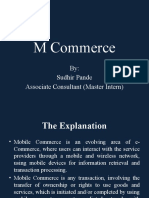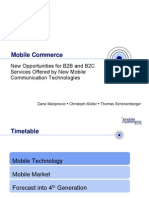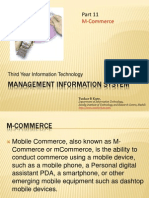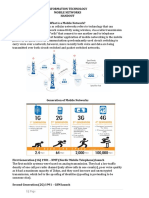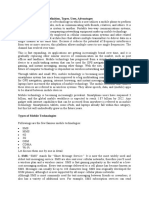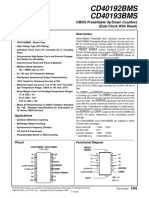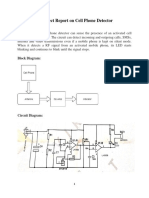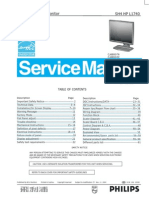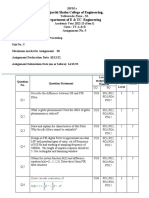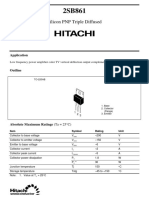Chapter 5: Mobile Electronic Commerce
5.1. Overview Mobile Electronic Commerce
M-Commerce is sometimes referred to as “Mobile E-Commerce”, or M-Commerce.
It is basically electronic transactions conducted using a mobile terminal and a wireless network.
Mobile terminals include all portable devices such as mobile telephones and PDAs, as well as
devices “mounted in the vehicles that are capable of accessing wireless networks” and perform
M-Commerce transactions.
“M-Commerce is the buying and selling of goods and services, using wireless hand-held
devices such as mobile telephones or personal data assistants. It is the ability to conduct
commerce using a mobile device such as:
Mobile phone.
Personal digital assistant (PDA).
Smartphone.
5.1.1 Mobile Applications & Methods of Payment
Individual mobile services of similar nature can be bundled into an application, e.g.
Mobile Ticketing or Mobile Banking. In the following, we present a brief overview of
diverse m-commerce applications.
Mobile Banking: This application makes it possible to complete bank-related
transactions, e.g. checking account status, transferring money and selling stocks, via
mobile devices, independent of the current user location.
Mobile Entertainment: This application contains services that provide the user digital
data with entertainment value on mobile devices, e.g. ring-tones, music and videos, on the
one hand. On the other hand, it opens an array of interactive services, e.g. betting, gaming,
dating and chatting. Mobile Information Services: This term refers to mobile services that
provide subscribers with content of informational character. Examples of such services are
news updates of any nature (finance, politics, sport etc.), travel information, access to
Lecture Note for 3rd year Students at Injibara University, Department of Marketing Management Page 1
� search engines and Mobile Office (e-mails, appointments etc.).
Mobile Marketing: This term refers to services based on mobile communication
technologies that provide firms with new, innovative instruments, e.g. to increase sales,
win and retain customers, improve after-sales services, build and sustain a positive and
modern image/brand and carry market research. Mobile devices serve thereby as simple
and relatively inexpensive channels of interaction.
Mobile Shopping: This application bundles services that allow for mobile
processing of transactions involving purchase of goods of daily use. The user can
purchase (mostly standardized) products by choosing them from a catalogue accessible
from a mobile device.
Mobile Ticketing: All services that must be paid for, before a lawful utilization can take
place, are suitable for Mobile Ticketing, e.g. travelling in public transport, entry to a
cultural event or cinema. This application ensures that the user can purchase a right to
utilization/entry (ticket) via a mobile device, replacing the conventional paper ticket. The
ticket is sent in digital form to the mobile device.
Telematics Services: Telematics is an artificial term that refers to innovative technologies
that link telecommunication technologies with informatics.
The transport segment has been the primary area of this application, which is also known
as Intelligent Transport System (ITS).
The main services are navigation systems, remote diagnosis as well as access to other
mobile applications such as Mobile Entertainment, Mobile Content/Office, Mobile
Banking and Mobile Shopping.
Lecture Note for 3rd year Students at Injibara University, Department of Marketing Management Page 2
� Mobile Applications
Applications Examples of Offered Services
Mobile Banking Mobile Accounting
Mobile Brokerage
Mobile Financial Information
Mobile Entertainment Mobile Gaming
Download of Music and Ring Tones
Download of Videos and Digital Images
Location-based Entertainment Services
Mobile Information Services Current Affairs (Financial, Sport and other News)
Travel Information
Tracking Services (Persons and Objects)
Mobile Search Engines and Directories
Mobile Office
Mobile Marketing Mobile Couponing
Direct (context-sensitive) Marketing
Mobile Payment: The term “Mobile Payment” refers to payments that are made via mobile
hand-held devices in order to purchase goods and services. Mobile Payment services usually
act as intermediary between consumer and the vendor.
• Is an alternative payment method. Instead of paying with cash, cheque or credit cards,
• A consumer can use a mobile phone to pay for a wide range of services and digital or hard goods
such as:
– Music, videos, ringtones, online game
– Transportation fare (bus, subway or train)
– Books, magazines, tickets
Lecture Note for 3rd year Students at Injibara University, Department of Marketing Management Page 3
� Advantage and disadvantages of M-commerce
Advantages
Offers many payment options
Push advertising, direct marketing.
More efficient and extensive service offered.
The Internet is going mobile
Can be easily setup
Disadvantage
Expensive cost
Larger screens won’t be displayed is clear
Slow speed
Limited for longer message
It hard way to fill the data.
Security is not protected
The M-commerce Systems Environment
Mobile Networks by ‘Generation’
1G: Analog Communication
World’s first cellular system launched in Saudi Arabia based on the Analog – 1981
Firstly, when wireless generation started, it was analog communication. That generation is 1G.
They used various analog modulations for data transfer. Now when the communication migrated
from analog to digital, the foundation of latest communication were led. Hence came 2G.
» The first generation of wireless technology, which was analog based.
» Only in certain environments, particularly in government agencies and the military
Lecture Note for 3rd year Students at Injibara University, Department of Marketing Management Page 4
� 2G: Based on Digital Technology (Voice+SMS/MMS)
It marked the start of digital voice communication era. Main motive of this generation was to
provide secure and reliable communication channel. It implemented the concept of CDMA and
GSM.
» 1G, lack of security and the proliferation of different wireless network standards
» 2G occurred in early 1990s
GSM (Global System for Mobile Communication)
» More global compatible telecommunication network
» European-Centric development
» Less costly
» Fully specify the complete network structure
As well as voice communications, 2G mobile phone can send and receive message
» SMS (Short Messaging Services)
» Mobile Internet Browsing, via the WAP (Wireless Applications Protocol)
3G: Third generation wireless communication (Voice + Data)
Lecture Note for 3rd year Students at Injibara University, Department of Marketing Management Page 5
� Then, the time of some decent speed internet connection and awesome voice channels has arrived.
They exploited area of Wideband-CDMA (W-CDMA), provided better bandwidth and better
connectivity even during motion(like in vehicle, train).
» 3G technology is aimed at providing a wide variety of services and capability in addition to
voice communication, such as Multimedia data transfer, video streaming, video telephony, and
full, unabridged Internet access
» Providing Data Centric Services with enhanced voices and multimedia capabilities
» 3G is to provide an economically viable and technology-enhanced PCS portal
» First introduced to Japan in 2001, and spread to Europe and USA in 2002
» digital, supported data, packet switched (WCDMA, EvDO)
4G: Forth generation wireless communication (Only DATA and Voice over data)
It is the Era of broadband wireless. This in the making and have been successfully deployed in
only some part of the world. Best aspect of 4G is the use of data services for everything. Internet
is the back bone and even voice call is done over internet. There is no separate voice channel. This
allows usage of wider bandwidth in the communication channel for data.
Reasons to Have 4G
» Support interactive multimedia
» Wider bandwidth, higher bit rates
» Global mobility and service portability
Lecture Note for 3rd year Students at Injibara University, Department of Marketing Management Page 6
� » Low cost
» Scalability of mobile networks
What’s New in 4G
» Entirely packet-switched networks
» All network elements are digital
» Higher bandwidth and lower cost (up 100Mbps)
» Tight network security
5G: Fifth generation wireless communication
» 5G = not yet defined
» Much faster. Likely to be real ~2020
5.2. Wireless Industry
Introduction
Wireless technology has already had an impact on your life today. Perhaps it was the ability to
quickly navigate a traffic jam with a mobile map application, or the convenience of sending a
quick text message to let someone know that you’re “on the way.” It is even possible that you
Lecture Note for 3rd year Students at Injibara University, Department of Marketing Management Page 7
� downloaded this report to a mobile device on which you’re now reading it.
Applications such as these, and advances in communications technology coupled with rapidly
decreasing costs, have resulted in tremendous growth in the adoption of wireless technology.
The entire US population was using a wireless phone. However, in a saturated market like the US,
wireless services grew steadily. Wireless services grew at an annual rate of ~6% from 2011 to
2013. During this period, wireless grew predominantly by increased usage—particularly from data
services. One of the key factors that led to wireless services’ growth was customers’ migration
from wire line to wireless.
Some of the key factors that contributed to the significant data usage growth include customers’
adoption of new devices, declining prices, and growing internet traffic.
Wireless communication is the transfer of information between two or more points that are not
connected by an electrical conductor. Wireless operations permit services, such as a long-range
communications, that are impossible or impractical to implement with the use of wires. The term
is commonly used in the telecommunications industry to refer to telecommunications systems
(e.g. radio transmitters and receivers, remote controls etc.) which use some form of energy (e.g.
radio waves, acoustic energy, etc.) to transfer information without the use of wires.[1]
Information is transferred in this manner over both short and long distances.
It encompasses various types of fixed, mobile, and portable applications, including two-way
radios, cellular telephones, personal digital assistants (PDAs), and wireless networking. Other
examples of applications of radio wireless technology include GPS units, garage door openers,
wireless computer mice, keyboards and headsets, headphones, radio receivers, satellite
television, broadcast television and cordless telephones.
Wireless services
Lecture Note for 3rd year Students at Injibara University, Department of Marketing Management Page 8
� Common examples of wireless equipment include:
• WiFi (wireless fidelity): Wi-Fi is a wireless local area network that enables portable
computing devices to connect easily to the Internet.
• Infrared and ultrasonic remote control devices
• Professional LMR (Land Mobile Radio) and SMR (Specialized Mobile Radio) typically
used by business, industrial and Public Safety entities.
• Consumer Two way radio including FRS Family Radio Service, GMRS (General Mobile
Radio Service) and Citizens band ("CB") radios.
• The Amateur Radio Service (Ham radio).
• Consumer and professional Marine VHF radios.
• Airband and radio navigation equipment used by aviators and air traffic control
• Cellular telephones and pagers: provide connectivity for portable and mobile
applications, both personal and business.
• Global Positioning System (GPS): allows drivers of cars and trucks, captains of boats and
ships, and pilots of aircraft to ascertain their location anywhere on earth.[10]
• Cordless computer peripherals: the cordless mouse is a common example; wireless
headphones, keyboards, and printers can also be linked to a computer via wireless using
technology such as Wireless USB or Bluetooth
• Cordless telephone sets: these are limited-range devices, not to be confused with cell
Lecture Note for 3rd year Students at Injibara University, Department of Marketing Management Page 9
� phones.
• Satellite television: Is broadcast from satellites in geostationary orbit. Typical services use
direct broadcast satellite to provide multiple television channels to viewers.
5.3. Wireless WANS
The Concepts of LANs, MANs, and WANs
Definition
a wide area network (WAN) is a geographically dispersed telecommunications network. The term
distinguishes a broader telecommunication structure from a local area network (LAN). A wide
area network may be privately owned or rented, but the term usually connotes the inclusion of
public (shared user) networks. An intermediate form of network in terms of geography is a
metropolitan area network (MAN).
Local Area Networks (LANs)
◦ On the customer premises
◦ Price is Highly related to cost
◦ Cost per bit transmitted is low
◦ Typical speed 100 MB to 1 GB per sec. or more
Wide Area Networks (WANs)
◦ Connect sites across a region, country, the world
◦ Price is Highly unpredictable
Lecture Note for 3rd year Students at Injibara University, Department of Marketing Management Page 10
� ◦ Cost per bit transmitted is high
◦ Typical speed 1 to 50 MB per sec.
Metropolitan Area Networks (MANs)
◦ Connect sites in a single metropolitan area (a city and its suburbs)
◦ Price is Highly unpredictable
◦ Cost per bit transmitted is Medium
◦ Typical speed 10 to 100 MB per sec.
Lecture Note for 3rd year Students at Injibara University, Department of Marketing Management Page 11
�12





